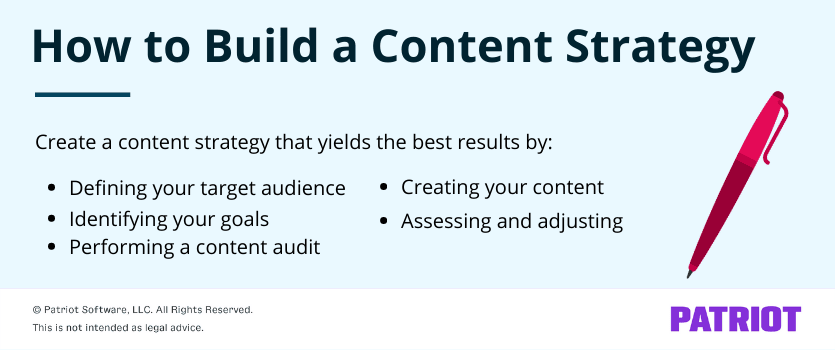In today’s highly competitive digital landscape, small businesses need a strong content strategy to stand out and succeed. A good content strategy can help small businesses like you boost brand awareness, drive traffic to your website, and generate leads.
Around 70% of B2C companies have a content marketing strategy. But with so many types of content and platforms available, creating an effective strategy can be challenging.
In this article, you’ll learn how to create a content strategy that yields the best results for your business
Building a winning content strategy
Want to build a content strategy but not sure where to start? Take a look at the following steps.

1. Define your target audience
Knowing who you’re speaking to is critical to a successful content marketing strategy. So before you start planning, define your target audience. They’re the people who will most benefit from your product.
To define your audience, create a buyer persona—a perfect customer. Think about who they are, where they live, how old they are, their spending habits, etc. Conducting persona research is important for those starting out or new to marketing.
Include the following information about your buyer persona:
- Background
- Demographics
- Challenges
- Goals
Also include how your business can help them. If you’re not sure where to start, you can research persona templates.
With the buyer persona, you can produce more relevant content they’ll want to read and that converts.
2. Identify your goals
After you decide who your content audience is, you need to define the goals of your content marketing strategy.
The ultimate goal of your content should be to sell. However, you can have more specific objectives for your content pieces.
So to achieve that sale, you might want to do the following:
- Generate leads
- Build brand awareness
- Increase your email subscribers
- Build customer loyalty
- Boost social media following
You can have one or more objectives for your content.
3. Perform a content audit
Before you start creating new content, you need to conduct an audit of your existing content. An audit helps you evaluate all of your content to determine what is working and what is not. This will help you identify content gaps, optimize existing content, and, ultimately, create a more effective content strategy.
So, list all your content pieces, including blog posts, videos, social media posts, and email newsletters. Include the title, URL, publication date, and other relevant information. You can do this using a spreadsheet.
Next, determine which of those pieces are performing well and which are not. Look at metrics such as page views, engagement, social shares, and conversions. You can generate this data by using Google Analytics or looking up statistics in your social media accounts and other tools.
Identify content gaps by analyzing your target audience’s needs and interests and comparing them to your content. Determine what content ideas and formats are missing from your content library.
Lastly, perform content optimization. Update blog posts and add internal links to other relevant content on your website. For this purpose, you can use a content management system.
4. Create your content
At this stage, you already know several things: your content goals and which of your existing pieces perform. Based on those, you can determine the types of new content to create.
Let’s assume you want to build brand awareness of your restaurant. Then, you probably need to write a blog post on how to make a burrito. If you see your social media post on your dish recipe has a lot of engagement, you might want to replicate that content.
But in content creation, you also need to consider the buyer’s journey. Different content types work for different stages of the marketing funnel.
As a small business, you want to create different types of content for every stage. The goal is to guide potential customers to the bottom so they can buy your product. Consider using a variety of formats, such as blog posts, videos, infographics, social media posts, and email newsletters.
It follows, of course, that you should also choose the right marketing channels to distribute content. These will depend on the channels your target audience uses and the nature of your product.
If your audience is millennials, you might want to focus your content marketing efforts on social media platforms like Instagram or YouTube instead of TikTok, that’s used by a younger audience.
When creating content, you should also focus on quality and authenticity. Around 83% of marketers think it’s better to create higher quality content less often than constantly producing new pieces of poor quality.
Your content should also be informative and valuable to your target audience.
5. Assess and adjust
After you publish your new content and optimize your old, evaluate their performance. Start with analyzing the data behind your content.
You can use tools such as Google Analytics for your blog posts, for example. Look at metrics like traffic, page views, and time on site to see which pieces of content resonate with your audience and which ones do not.
As part of your social media content strategy, use in-built analytics tools to look at engagement levels. If you send emails, use email marketing platforms to see if open and click-through rates, etc.
Now, analyze your data. Make adjustments to improve your content strategy. For example, if you notice that certain types of content are performing, create more of that type of content.
Update posts for relevance and SEO performance. If your content pieces rank lower than before, apply best SEO practices to increase their visibility in search engines.
These views are made solely by the author.

